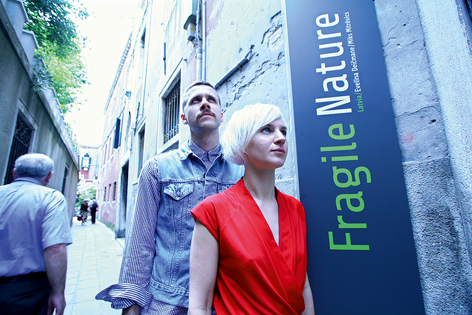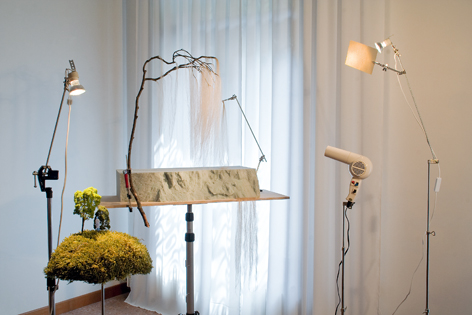|
|
| All About Themselves Solvita Krese, art historian | |
| In the introduction to the catalogue, the director of the Venice Biennale 53rd International Art Exhibition Daniel Birnbaum sketches in an overall picture of our modern world, where nations are confronted by the processes of globalisation, and artists create their works in the tension zone created by these two opposing poles. Internationalisation could also be a force for freedom, which liberates the individual from the restrictions of their local culture, but, without a doubt, there is a homogenising tendency at work here as well, which tends to minimize cultural diversity and threatens to transform the world into a monotonous sameness. Art could be an antidote to this sort of levelling out, accenting the differences, yet has nothing in common with the return of political nationalism, says Birnbaum. | |
 Miks Mitrēvics and Evelīna Deičmane in the Venice biennale. Photo: Kristīne Kursiša | |
| The various aspects of the concept of national identity, or rather belonging, have in recent times become a widely debated topic in international artistic circles. The subject was discussed at the IKT (International contemporary art curator association) congress, which recently took place, and has featured in a number of international art projects. It is symptomatic that a number of national pavilions at this year's Venice Biennale presented exhibitions which challenged the principles of traditional national representation. In the German pavilion, for example, there was a work by the British artist Liam Gillick. The curator of the exhibition Nikolaus Schafhausen, defending his choice, said that the German pavilion has never been merely an exhi-bition space. It is a structure highly charged with ideology, and does not conform to the classical format of an exhibition. Liam Gillick offers a view "from the outside", commenting on Germany's historic experience and reference to it in the symbolic attributes used in the pavilion itself. The pavilions of the Nordic countries and Denmark this year were united in a joint "transnational neighbours" exposition. The curators Michael Elmgreen and Ingar Dragset had turned the national pavilions into mock private homes of art collectors, leading the viewer to understand that the family living in one house are about to divorce, and that their neighbours are faring no better: one of the gay couple next door has drowned himself in the backyard swimming pool. The exhibition is made up of works by artists from various countries of Europe. The curators have overturned the idea of the pavilion as a platform for national representation, in its place offering a reflection on issues of culture, sexuality and spirituality from the standpoint of an individual. Often enough the message of a nation is manifested in documentation or works underpinned by ideological and social realities. In Estonia's exhibition, for example, one could follow Kristina Norman's chain of documentation and provocation, which depicts the moving of the bronze soldier in Tallinn, which, from being a memorial has turned into a contradictory and powerful symbol of authority in Estonia's two community society. A similar strategy had been chosen in the last Venice Biennale by the Lithuanians Nomed and Gedminas Urboni, whose exposition was awarded one of the "Golden Lions". Unfolding the story about the fate of the Lithuanian Embassy in Rome, the artists stirred up a number of ideologically sensitive areas in Lithuania's history, which are continuing to resonate in today's society. | |
 Liam Gillick. Untitled. 2009. Publicity photo | |
| The current tendency on the international art scene, however, marks a movement away from "social claptrap" (a description which has been heard in Latvian artistic circles), and a return to references to modernism and the problems of perception, as was evident in both the last documenta as well as the Berlin Biennale. Another line in the direction of art is the interest in empirical observation, about feelings, the "small" stories, which was to a large extent noticeable in Manifesta 7. Both authors of Latvia's exhibition this year, Miks Mitrēvics and Evelīna Deičmane, were among the participants in Manifesta 7. In Venice the artists continued to develop the evolution of ideas which had begun in previous years. In the work ‘Fragile Nature' created for the Latvian exhibition by Miks Mitrēvics, the sun was given pride of place as one of the primary sources of life and nature. A little train, running on batteries charged by solar power, departs and returns again, as if a continual reminder to remember happy moments and feelings. Just like the never-ending hunger for sunlight among people in Northern Europe causes them to "recharge their batteries" with the warmth of positive memories, and to spend their accrued emotions cautiously. | |
 View from the Latvian exhibition Fragile Nature. In the foreground: Miks Mitrēvics. Fragile Nature. Fragment of the installation. On the right: Evelīna Deičmane. Season sorrow. Fragment of the installation. Photo: Kristīne Kursiša | |
| Nature as an external, self-sufficient force, which has the ability to influence the course of a person's life, becomes a unifying motif in the works of both authors. For Miks it is the sun. Evelīna utilises snow for the materialisation of the idea, which, turning into a metaphor, allows the thread of the story to be woven into a new texture. Season Sorrow is rolled into a snowball, which like the wheel of samsara turns around itself the boredom of everyday cares and worrying thoughts, becoming ever larger and larger. The small cog, transferring the power to the larger cogs, sets off a record playing the sound of snow being rolled. The interest in sound, its transferral from creation to source of reproduction has been evident in the artist's previous works (Elves and Jupiter, Diameter 761, Nje mechtaj i nje dumaj (Russian: ‘Don't dream and don't think')). Sound is also essential in the video installation, where people's heads trapped in snow send out signals of helplessness and loneliness, about the inability to move and to meet. Whispers and sighs mingle with the sound of dripping melting snow and the panting of the wind. A sizeable wooden structure, which has been integrated by video and by sound into a room constructed specially for the purpose, hides two modest videoscreens, as if emphasizing their lack of importance. It seems that the pursuit of perfection of craftsmanship and the hunt for technical solutions have occupied the greater part of the process in the creation of the work, stealing time and strength which would have been useful when bringing out the narrative message of the work. However, in contrast to many young artists who work with the production of simulacra, thus affirming that they know what a "good" piece of art should look like, yet all too often forgetting about the actual contents or message, Miks and Evelīna show themselves to be mature artists, and convincing the viewer that "everything is for real". The translation of the imprints left by personal experience into the language of visual imagery lead one to believe, to think and to remember - to remember the works even after leaving the exhibition hall. | |
 Miks Mitrēvics. Fragile Nature. Fragment of the installation. Photo: Kristīne Kursiša | |
| Of course, a lot is determined by the specifications of the space. The Latvian pavilion was placed in quite a good geographical location, where a number of national pavilions were to be found, and on the path of the tourist trail. Nevertheless the space itself causes the artists to crowd together, as if crouching down. Miks' little train seems like an accidentally forgotten playground item next to Evelīna's installations. The artist's video work seems to have been inveigled into a box that is too small for it, which does not permit proper absorption of the particular atmosphere generated by the sound. The pavilion of Latvia in Venice's art "carnival" was noticed, and showed up well against the background of the central exhibition. In informal chats between international art experts and curators the name of Miks Mitrēvics was often mentioned. The exhibition put together by Daniel Birnbaum could be described as a calculated construction of the mind, a wandering among investigations about perception, where a great deal of attention was concentrated on the classics of today (the Gutai group, Lygia Pape, Gordon Matta-Clark and others) and the huge exhibition halls were filled with delicate trinkets. Yet it felt altogether too tame and, in places, boring. The tiredness elicited by the major exhibition was refreshed by the Latvians, with the presence of emotion and intriguing visualisations. Both of our artists talk in the first person and tell us about themselves, which often is more lively and convincing than a wallow in the maelstrom of global problems, or an attempt to touch the big narratives and grapple with an analysis of the situation. In genre quite different, but fairly successfully, a number of other biennale artists relate their personal stories. For example, the Dutch video artist Fiora Tan, in whose work biographical events are interlinked with the history of her family, or the Icelandic artist Ragnar Kjartansson, who, with a hint of irony, plays out the role of the artist in somewhat widely differing aspects. At the opening of the Latvian pavilion I notice over my shoulder a well-known art critic, who, in his biennial programme of events, puts a ring around the name of Latvia and adds an exclamation mark. "That's good", I think to myself. /Translator into English: Terēze Svilane/ | |
| go back | |







